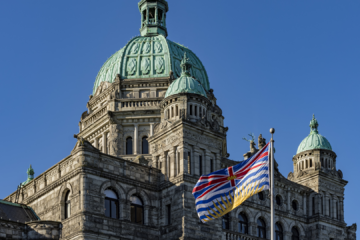BC Accessibility Legislation Consultation Report Released
May 7, 2020
BY Sara Pon
Accessibility Legislation
In late 2019 the Province of BC engaged in consultation to develop comprehensive accessibility legislation. The government released the British Columbia Framework for Accessibility Legislation report (BC Framework) to outline their proposed approach to accessibility legislation. The report notes that accessibility legislation is needed because a quarter of the population in BC is living with a disability, and people with disabilities experience many barriers in everyday life preventing them from meaningfully participating in all aspects of community. Accessibility matters to older adults, as many live with lifelong or newly acquired disabilities.
The BC government sought feedback from the public on what they liked and didn’t like about the proposed legislative model. The consultation period ran from September 16 to November 29, 2019. The Summary Report Accessibility Legislation Consultation was released on February 5, 2020. This document outlines the feedback received through the online questionnaire, community meetings, town halls, formal submissions, and email, video, and phone comments. You can also read submissions made by various organizations.
The federal government enacted the Accessible Canada Act (ACA) which came into force on July 11, 2019. The ACA, applying to everything under federal jurisdiction, is intended to remove barriers to create a barrier-free country by 2040. The ACA sets out how accessibility standards will be developed, and identifies duties of agencies under federal jurisdiction in preventing barriers to all people, especially people living with disabilities.
This blog will describe BC’s proposed framework for accessibility legislation in BC and highlights some of the public feedback from consultation. In a future blog we will outline the ACA provisions, which the BC legislation will likely mirror.
Accessibility Legislation Principles
The province would like to implement a comprehensive framework for ensuring that barriers are removed and prevented from occurring so people living with disabilities can fully participate in all aspects of society. The design of this legislation will be informed by consultation with people living with disabilities and three types of laws:
- United Nations’ documents such as the Convention on the Rights of Persons with Disabilities (CRPD) and the Declaration on the Rights of Indigenous Peoples;
- The ACA; and
- Other accessibility legislation.
Goals of the Legislation
The BC Framework notes three themes that are key in building the province’s accessibility legislation: breaking down barriers; advancing human rights; and promoting fairness and equality.
- Breaking Down Barriers
The BC Framework notes that a quarter of the population is living with a disability. They experience barriers to meaningfully participating in communities, which must be addressed in the legislation.
The consultations showed that a common theme in feedback was the need for universal design. The definition of disability also needs to be broad enough to encompass a full range of disabilities, such as episodic disabilities and invisible disabilities like mental illness and brain injuries.
Feedback revealed a wide array of barriers faced by people living with disabilities, including physical, attitudinal, financial, and communication barriers.
- Advancing Human Rights
The BC Framework notes that human rights legislation only addresses individual complaints and is not an effective method of removing systemic barriers to accessibility. The legislation is aimed at removing systemic barriers.
The consultations revealed a strong desire for the legislation to implement CRPD principles, especially “nothing about us, without us”. The legislation should be aimed at systemic barriers and be broad and comprehensive.
- Promoting Fairness and Equality
The BC Framework notes that people living with disabilities are a diverse group with different backgrounds, experiences, and needs. The legislation must reflect the diverse needs of people living with disabilities.
The consultations showed a need for ensuring equal access to opportunities. The legislation must reflect equality in geographical differences, intersectionality, and the wide range of backgrounds and experiences of people living with disabilities.
The BC Framework explains that the provincial legislation should be aligned with the federal ACA and other existing provincial accessibility acts. Legislation and standards should be developed with people living with disabilities. The principles underlying the legislation are self-determination, inclusion, adaptability, diversity, and collaboration.
Consultation Feedback on Accessibility Standards
The BC Framework suggests accessibility standards could address a wide number of areas, including service delivery, employment, the built environment, information and communication, and transportation. A mix of voluntary and mandatory standards is suggested.
The consultation sought feedback on what kind of standards should be developed and in what areas. Most of the feedback emphasized process and noted the importance of developing standards with people living with disabilities and other stakeholders. The need for universal accessible design was a strong theme throughout the consultation feedback. The consultation report broke feedback down into five areas, and most of the people providing feedback thought that all areas were important.
- Service Delivery
Standards for service delivery should be broken up, as this area is very large and encompasses health care, education, and retail, among other areas. Staff need to be trained to ensure effective communication and reduce barriers.
- Employment
Employment barriers occur not only in obtaining meaningful employment, but also in ensuring the workplace is accessible and the employee’s individual needs are accommodated. Employers must be flexible in job requirements.
- Built Environment
In addition to universal design of the built environment, accessibility is required beyond initial construction and design. The environment must be maintained, have good signage, be easy to navigate, and have the interior design be accessible.
Affordable and accessible housing and accessible parking were areas which particularly need accessibility standards and enforcement.
- Information and Communication
There are many barriers in access to information. Websites and other forms of information are often not in an accessible format. Also, information can be too complex, and this proved a barrier to some people.
- Transportation
Consultation feedback identified a need for more accessible transportation, and for transportation staff to be better trained.
The need to book accessible transit far in advance can be problem. This approach does not allow people living with disabilities much flexibility in their daily lives.
Governance and Enforcement
The BC Framework suggests creating a variety of offices to oversee standards development and enforcement of the new legislation, including a government office to create information and tools for the community, a board to develop accessibility standards, and an accessibility commissioner to enforce the legislation.
The BC Framework says the new legislation could use a mix of incentives, compliance requirements, and enforcement methods to put the accessibility legislation into practice.
- Incentives could include awards, funding for training, financial incentives, and reduced reporting requirements.
- Compliance requirements could include accessibility plans, progress reports, feedback mechanisms, and creating places to find tools, resources, and training.
- Enforcement methods could include inspections, mediation, public reporting of barriers, and monetary penalties.
The consultations focused a great deal on incentives, compliance, and enforcement, raising the importance of training, accessibility inspections, accessibility plans, and progress reports. Comments also emphasized the importance of:
- Creating a single point of contact for questions and complaints about accessibility legislation
- Ensuring oversight of accessible standards and legislation
- Involving people living with disabilities and other stakeholders
- Imbedding effective compliance enforcement measures into the legislation
- Building-in incentives, such as tax incentives, resource hubs, and training programs
- Creating funding programs to support accessibility
- Providing training and raising public awareness to create a culture of inclusion
The BC Framework states that legislation could include periodic legislative review, and reporting what steps have been taken to accomplish the goal of a barrier-free BC. The BC Framework notes that review is important to ensure accountability and transparency, but this goal must be balanced with avoiding excessive reporting requirements so as to not hinder the implementation of the legislation thru bureaucracy.
Culture Change
The BC Framework notes that creating accessibility legislation is important, but legislation is just one piece of creating a fully accessible province. A culture change is needed. Feedback from consultations demonstrated a strong desire for the legislation to be one part of a larger cultural shift. Some themes that came up:
- Education and awareness-building are critical. This means increasing the visibility of people living with disabilities, integration in schools, education for the public, and training for professionals.
- Meaningful inclusion for people living with disabilities goes beyond just removing barriers.
- Governments should be leaders in accessibility, including accessibility of all government services and built environments, and training and education for staff.
- Consistency across jurisdictions is important, so provincial ministries should work together, and the province should work with federal, municipal and Indigenous governments to ensure consistent accessibility standards and legislation.
Resources and Information
For more information on the BC accessibility framework visit the BC Government’s consultation page.
For information on BC Building Codes on accessibility visit the BC Government’s building codes page.
For federal accessibility standards, visit the newly-created Accessibility Standards Canada page.
For resources on inclusion, visit disability organizations’ websites:












































